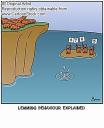Human Lemmings?
 Before I continue with this story, I wish to make it perfectly clear that I am in no way humouring this subject. On the contrary, I’m attempting to highlight this afflictive social dilemma, thereby drawing attention to it. In fact, the popular notion of that «Lemming commit mass suicide» is a misconception. It’s not helped by lemming cartoons such as the one shown here. I can almost guarantee that I’ll get more exposure by tying this sad story in with Lemmings, if only because «Lemming Suicide» is a much more popular search term than «Innu people of Nitassinan, Davis Inlet in the Labrador-Quebec peninsula, eastern Canada». But the real focus of this article is that some human cultures and communities are more prone to suicide than others, especially when entire societies are relocated. I will speculate about this further in future articles.
Before I continue with this story, I wish to make it perfectly clear that I am in no way humouring this subject. On the contrary, I’m attempting to highlight this afflictive social dilemma, thereby drawing attention to it. In fact, the popular notion of that «Lemming commit mass suicide» is a misconception. It’s not helped by lemming cartoons such as the one shown here. I can almost guarantee that I’ll get more exposure by tying this sad story in with Lemmings, if only because «Lemming Suicide» is a much more popular search term than «Innu people of Nitassinan, Davis Inlet in the Labrador-Quebec peninsula, eastern Canada». But the real focus of this article is that some human cultures and communities are more prone to suicide than others, especially when entire societies are relocated. I will speculate about this further in future articles.
The Innu consist of «a grouping of the Montagnais, Naskapi and Atikamekw aboriginal peoples of northeastern Quebec, and another group in Labrador in the province of Newfoundland.» In 1967, the Newfoundland government convinced the Mushuau Innu (the people of the barrens) to abandon their traditional location on the mainland of Labrador where they had been nomadic hunters of caribou for about six millennia. Unfortunately, nobody in the government appears to have taken into account that centuries of their «pride, traditions, and spirituality [were] tied to the land of their ancestors…» They were resettled on the Davis Inlet where they were expected to establish a fishery. «…their social fabric soon fell apart.» The provincial government reneged on its promises of fresh water and sewage systems. Suicide rates mounted.
 www.survival-international.org reports that the Innu people in Canada’s northeastern regions have the highest suicide rate in the world: 178 per 100,000 persons per year. The report states that «Utshimassits is a community living in almost unimaginable squalor and disarray. They described wooden shacks with no running water, poor roads and scant health care. These conditions are reflected in the appalling health and mortality statistics for Davis Inlet, where family breakdown, sexual abuse, drunkenness and alcohol-related disease, violence, accidents and self-harm become endemic.»
www.survival-international.org reports that the Innu people in Canada’s northeastern regions have the highest suicide rate in the world: 178 per 100,000 persons per year. The report states that «Utshimassits is a community living in almost unimaginable squalor and disarray. They described wooden shacks with no running water, poor roads and scant health care. These conditions are reflected in the appalling health and mortality statistics for Davis Inlet, where family breakdown, sexual abuse, drunkenness and alcohol-related disease, violence, accidents and self-harm become endemic.»
According to the Toronto Star newspaper, there are two main causes:
1) Incompetent, paternal, racist government policies under the guise of benevolent progress, and
2) The sexual and physical abuse of Innu children at the hands of a small minority of Roman Catholic priests over a period of generations.
 You can read an overview about the Innu people on Wikipedia. To make a donation with www.survival-international.org, click here. For further informatio, I urge you take a look at the official Innu website. There’s a much longer article about Inuit people, a culturally similar indigenous peoples inhabiting the Arctic regions of Alaska, Greenland, and Canada.
You can read an overview about the Innu people on Wikipedia. To make a donation with www.survival-international.org, click here. For further informatio, I urge you take a look at the official Innu website. There’s a much longer article about Inuit people, a culturally similar indigenous peoples inhabiting the Arctic regions of Alaska, Greenland, and Canada.
Mass Lemming Suicides a Common Misconception:
Lemmings of northern Norway are one of the few vertebrates who reproduce so quickly that their population fluctuations are chaotic, rather than following linear growth to a carrying capacity or regular oscillations. It is unknown why lemming populations en mass fluctuate, roughly every four years, before plummeting almost to extinction.
While many people believe that lemmings commit mass suicide when they migrate, this is not the case. Driven by strong biological urges, they will migrate in large groups when population density becomes too great. Lemmings can and do swim and may choose to cross a body of water in search of a new habitat. On occasion, and particularly in the case of the Norway lemmings in Scandinavia, large migrating groups will reach a cliff overlooking the ocean. They will stop until the urge to press on causes them to jump off the cliff and start swimming, sometimes to exhaustion and death. Lemmings are also often pushed into the sea as more and more lemmings arrive at the shore.
The myth of lemming mass suicide is long-standing and has been popularized by a number of factors. In 1955, Carl Barks drew an Unlce Scrooge adventure comic with the title: The Lemming with the Locket. This comic, which was inspired by a 1954 National Geographic article, showed massive numbers of lemmings jumping over Norwegian cliffs. The suicide myth was further propagated by Walt Disney documentary White Wilderness in 1958 which includes footage of lemmings migrating and running head-long over a ledge. An investigation in 1983 by the Canadian Broadcasting Corporation’s Brian Vallee, showed that the Disney film makers faked the entire sequence using imported lemmings (bought from Inuit children), a snow covered turntable on which a few dozen lemmings were forced to run, and literally throwing lemmings into the sea to show the alleged suicides. Source – Wikipedia.
Ironically, one source reports that they paid Inuit children from Manitoba 25 cents for each lemming they caught.





In your blog on the Innu you showed the Flag of the Nunatsiavut which is the flag of the Inuit population living in Labrador. The Innu and the Inuit are two distinct groups. The Innu are part of Canada’s First Nations commonly misnamed «Indians» whereas the Inuit are not First Nations but rather a seperate people who are commonly misnamed «Eskimo’s». Having said all that I find that most Canadians do not know that they are two distinct groups of people simply because their names sound alike.
Thanks very much for the clarification Roger, I appreciate it.